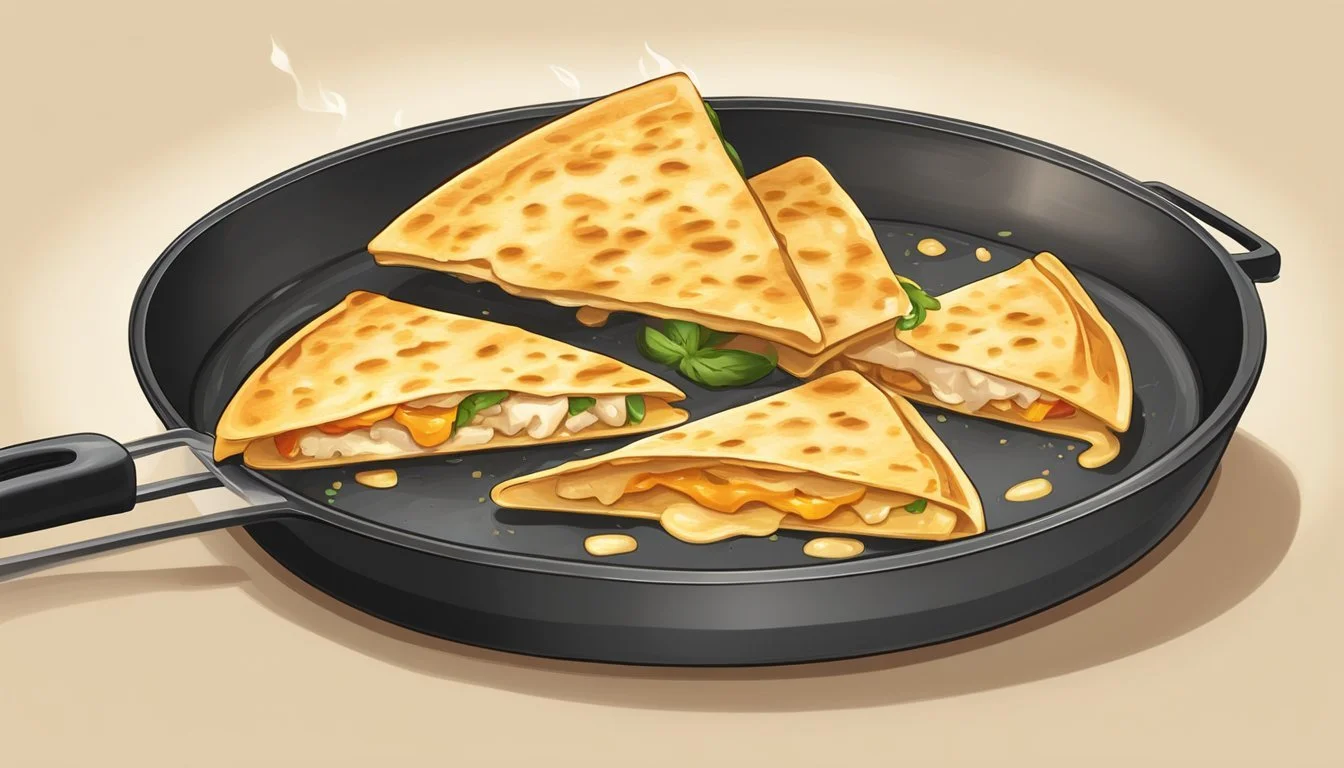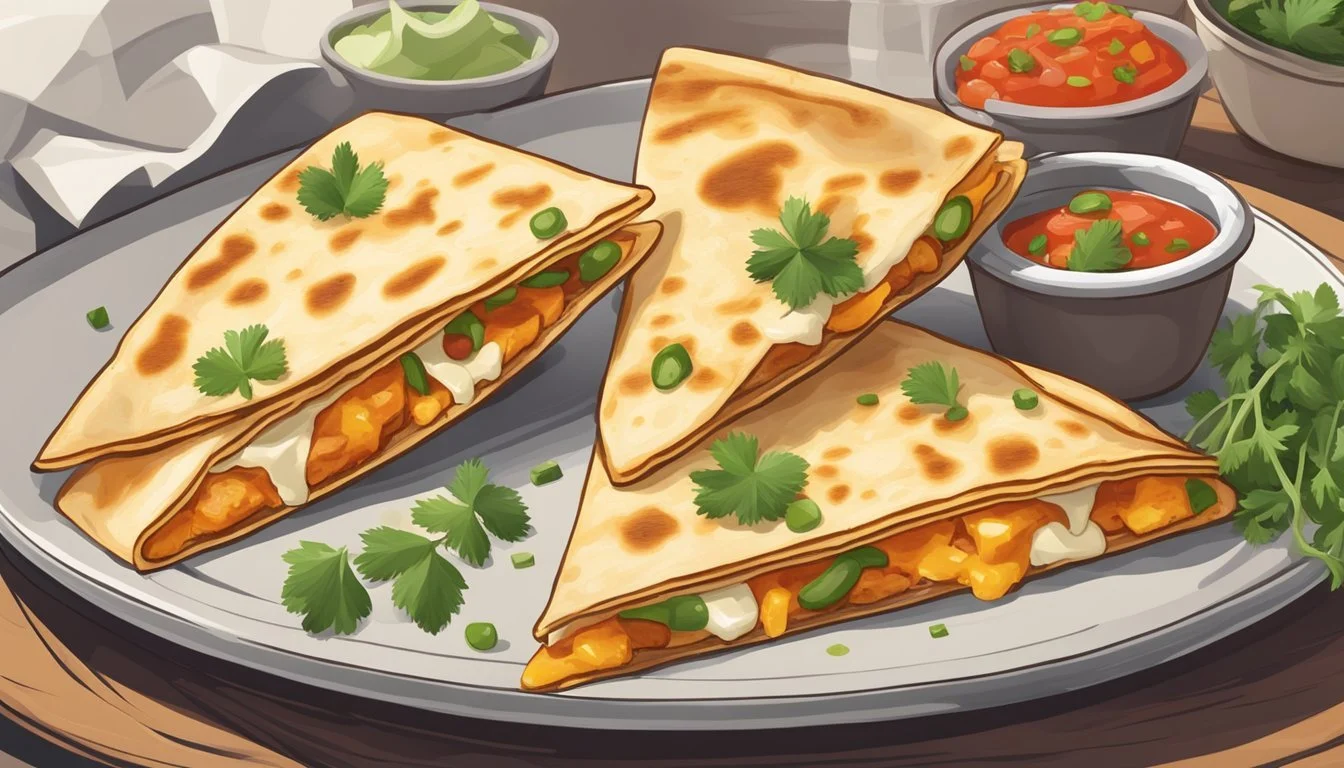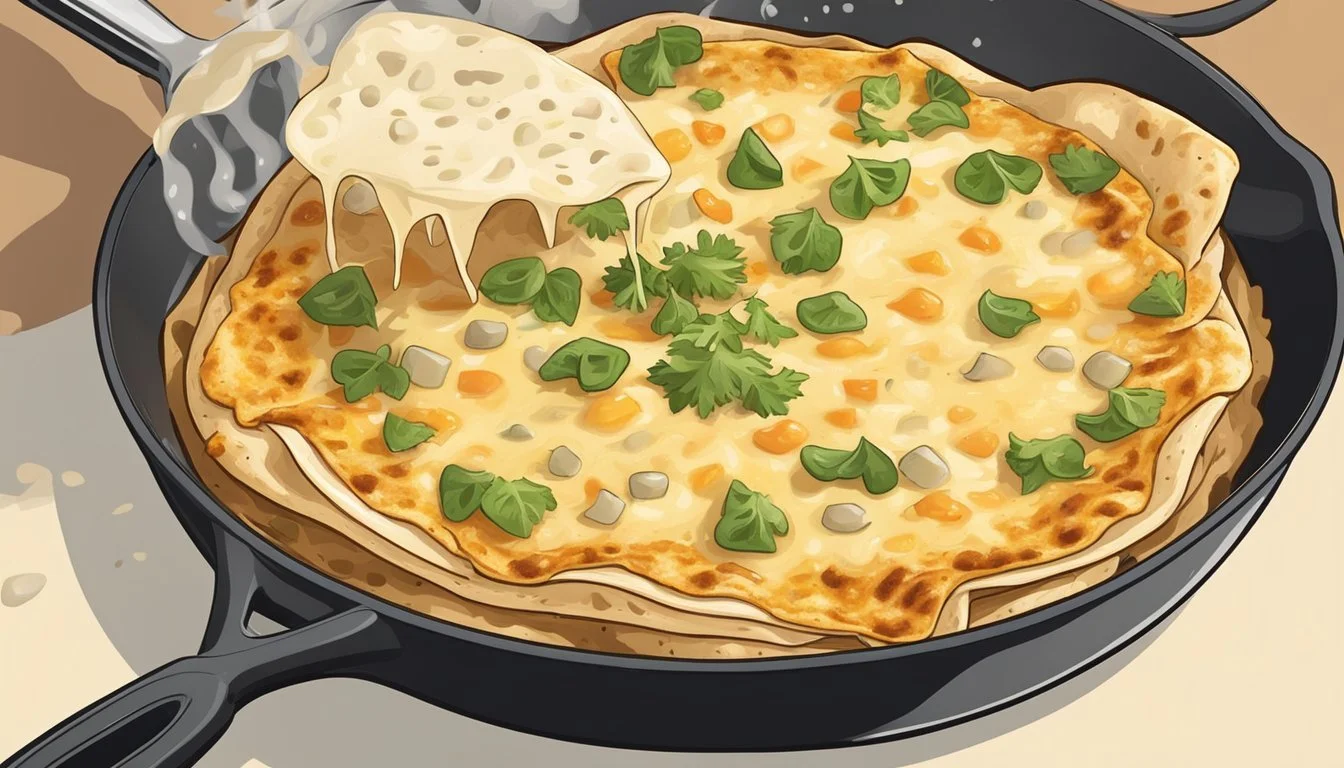Best Way to Reheat Chicken Quesadilla
Crisp Tortilla, Melted Cheese Tips
Reheating a chicken quesadilla to achieve the perfect balance of a crispy tortilla and melted cheese can be an art form. Whether it’s a leftover from a local eatery or a homemade creation, knowing how to properly reheat this popular Mexican dish is essential to enjoy its full flavors and textures. The key is to employ methods that not only warm the filling but also revive the tortilla's original crispiness without overcooking.
Several techniques can be used to reheat a quesadilla, with each offering its advantages. The stovetop method, for instance, is a quick and effective way to recrisp the tortilla while ensuring the cheese is sufficiently gooey. On the other hand, an air fryer can provide an evenly heated quesadilla with a desirable texture in a matter of minutes. Moreover, if one anticipates a larger batch or desires a hands-off approach, using an oven can be an efficient alternative to reheat multiple quesadillas at once.
Selecting the right method and understanding the steps involved are crucial to avoid a soggy or burnt quesadilla. Preheating the chosen appliance, using the right amount of heat, and timing the process carefully are all important factors in reheating a quesadilla successfully. Each method has its unique set of steps to ensure the ultimate balance of a crispy exterior and a warm, melted interior, creating a dish that's almost as good as when it was first served.
Understanding the Quesadilla
A quesadilla consists of a tortilla, typically made from wheat flour or corn, filled with cheese and often other ingredients like chicken, and then folded and cooked until the cheese has melted and the tortilla turns golden and crispy. Chicken quesadillas are particularly popular, combining the rich flavors of seasoned chicken and melted cheese within a warm tortilla.
When discussing leftover quesadillas, preserving the texture of the tortilla while ensuring the cheese remains melted is a culinary challenge. Proper reheating methods are crucial to reviving the original taste and texture of the quesadilla. Considering the various kinds of tortillas, flour tortillas are commonly used for quesadillas due to their flexibility and ability to crisp up nicely when cooked.
The cheese choice is also vital to a quesadilla's quality. Melting cheeses such as cheddar, Monterey Jack, or Mexican blends are favorites, providing gooeyness and flavor. When reheating a leftover quesadilla, the goal is to restore the crispy exterior of the tortilla and the creamy, melted interior without overcooking the cheese or drying out the chicken.
In summary, a quesadilla skillfully balances the textures and flavors of its limited ingredients. Keeping these elements in prime condition upon reheating requires specific techniques that honor the simplicity and integrity of the original dish.
Preparation for Reheating
Before reheating a chicken quesadilla, ensuring that the tortilla remains crispy and the cheese perfectly melted requires preparation. This section outlines the specific tools and hygiene protocols necessary to achieve the best results.
Gathering Necessary Tools and Ingredients
Oven Method:
Baking sheet
Aluminum foil or parchment paper
Wire rack (optional for even heating)
Microwave Method:
Microwave-safe plate
Paper towel or microwave-safe cover
Stovetop Method:
Skillet (non-stick or cast iron)
Spatula
Cooking oil (optional for added crispness)
Every reheating method demands particular kitchen tools to ensure quality. For oven reheating, preheat the oven and line a baking sheet with aluminum foil or parchment paper for easy cleanup. When using a wire rack, it elevates the quesadilla, allowing heat to circulate and keeping the tortilla crisp. Microwave reheating is quicker but may not keep the tortilla as crisp; however, covering the quesadilla with a paper towel helps absorb moisture. The skillet method requires a stovetop and may include a light coating of oil for that ideal crispy texture.
Safety and Hygiene Considerations
Before Handling Food:
Wash hands thoroughly with soap and water.
Sanitize surfaces and kitchen tools.
During Preparation:
Use tongs or spatulas to manipulate the quesadilla to avoid burns.
Never leave reheating food unattended to prevent overcooking or potential fire hazards.
Food safety must not be compromised while striving for the perfect reheated quesadilla. Hands and surfaces should be cleaned, and all ingredients, like chicken, should have been stored properly before use. Monitoring the reheating process closely not only ensures a delicious outcome but also maintains a safe cooking environment.
Reheating Techniques
Reheating a chicken quesadilla properly can ensure that the tortilla remains crispy and the cheese inside melts evenly. Each method offers a unique balance between maintaining the crunchy texture of the tortilla and the creamy quality of the cheese.
Oven Method
One common way to reheat a quesadilla involves using an oven. Preheat the oven to 350°F and place the quesadilla on a baking sheet lined with parchment paper for optimal results. This allows for an even distribution of heat, warming the quesadilla thoroughly without making it soggy. For added crispness, a piece of aluminum foil can be placed loosely over the top to reflect heat and prevent excessive browning.
Stovetop Method
For those seeking a quick yet effective technique, the stovetop method provides excellent control. Heat a skillet over medium heat and place the quesadilla in the pan. It is advisable to cover it with a lid for a few minutes to help the cheese melt uniformly. Removing the lid for the last few minutes will restore the tortilla's crispy texture.
Microwave Method
When speed is of the essence, the microwave can reheat a quesadilla quickly, though it may not keep the tortilla as crisp as other methods. Place the quesadilla on a microwave-safe plate and use short 30-second bursts of heat to warm it through. While this method is the fastest, one might sacrifice some texture for convenience.
Air Fryer Method
An air fryer can make quesadillas pleasantly crunchy. Heat the air fryer to 350°F and place the quesadilla inside for approximately 3-4 minutes. This allows the exterior to gain a crispy texture, similar to the original cooking method, while the inside becomes hot and the cheese adequately melted.
Toaster Oven Method
Similar to a conventional oven, the toaster oven can deliver a well-reheated quesadilla with a crisp exterior. Set the toaster oven to 350°F and use a piece of foil or a toaster oven tray to prevent sticking. Monitor closely to ensure that the quesadilla does not overcook, as toaster ovens can vary in temperature.
Alternative Reheating Options
If one desires to add new life to leftover quesadillas, consider incorporating fresh vegetables or spices to the dish while reheating. These can be added into a skillet alongside the quesadilla, wrapped in foil with it in the oven, or even sprinkled on top for reheating in the air fryer or toaster oven. Additionally, sides like sour cream can be served to complement a re-warmed quesadilla.
Troubleshooting Common Issues
When reheating a chicken quesadilla, it's important to preserve the crunch of the tortilla and the meltiness of the cheese. Several common issues can arise during reheating that can affect the quality of your quesadilla. The goal is to avoid sogginess, ensure even heating, revive the flavors and textures, and follow safety guidelines.
Avoiding Sogginess
To keep quesadillas from getting soggy, start with a cold quesadilla from the refrigerator or freezer. One should avoid covering the quesadilla with a lid when reheating, as this traps steam and moisture. Instead, reheating in an oven or air fryer can maintain or even enhance the tortilla’s crispiness. For oven reheating, place the quesadilla directly on a clean oven rack and bake at 350°F for roughly 10 minutes; this allows air to circulate and prevents steam buildup.
Ensuring Even Heating
Even heating is crucial to achieve a uniformly warm and crisp quesadilla. It's advisable to let refrigerated quesadillas sit at room temperature for about 15 minutes before reheating to reduce temperature disparity. When using an air fryer, give the quesadilla a light spray of oil and reheat at 350°F, checking progress and flipping if necessary, usually after 3 minutes. This helps in heating the quesadilla evenly while adding to its exterior crunch.
Reviving Flavor and Texture
The leftover quesadillas might lose some of their original flavors and textures. To revive flavor and texture, consider adding fresh toppings like chopped cilantro or a sprinkle of cheese on top just before the quesadilla finishes reheating. A light dusting of spices can also refresh the flavor profile without overwhelming the original taste.
Safety Tips for Reheating Food
Food safety should not be overlooked when reheating any leftovers, including chicken quesadillas. The heated quesadilla should reach an internal temperature of 165°F to ensure it is safe for consumption. Use a food thermometer to check. Always reheat only once as multiple reheats can compromise both the safety and quality of the quesadilla.
Serving and Presentation
Once a chicken quesadilla is perfectly reheated, achieving a crispy tortilla and melted cheese, presentation is key to both visual appeal and flavor enhancement. Serving it while it's hot ensures maximum enjoyment.
One should consider cutting the quesadilla into wedges for easy consumption. Place the slices in a circular pattern on the plate, making sure each piece is accessible. This also lends itself to a visually appetizing arrangement that invites diners to indulge.
Toppings and sides can elevate the experience. A dollop of sour cream can add a cool, tangy contrast to the warm, spiced chicken and cheese. Salsa, with its vibrant colors and fresh taste, not only brightens up the plate but adds a juicy component to each bite. For those who prefer a creamy texture with a hint of freshness, guacamole is an excellent companion. Drizzles or small bowls of hot sauce can cater to individuals who favor a spicy kick.
Favorite Toppings Description Suggested Serving Sour Cream Adds cool tanginess Side or dollop on top Salsa Provides freshness Side or layered on top Guacamole Creamy and fresh Side or dropfuls on top Hot Sauce Spicy kick Drizzle or side Avocado Slices Smooth buttery notes On top or side Fresh Cilantro Aromatic herbaceousness Sprinkle on top
Lastly, a garnish of fresh cilantro can provide an aromatic touch to the quesadilla, complementing its overall flavors. It is suggested to sprinkle finely chopped cilantro across the top for an herbaceous note.
They should serve the quesadillas immediately to ensure the tortilla retains its crispy texture and the cheese its delightful melt, making each bite as satisfying as the first.
Storage and Food Safety
Proper storage and reheating techniques ensure that chicken quesadillas remain delicious and safe to eat. This section outlines the best practices for storing leftovers, freezing and thawing quesadillas, reheating previously frozen quesadillas, and maintaining general food safety.
Storing Leftovers
After enjoying a meal, it's important to store leftover chicken quesadillas in the refrigerator within two hours of cooking to prevent bacterial growth. They should be kept in an airtight container or tightly wrapped in plastic wrap or aluminum foil to maintain freshness and should be consumed within 3-4 days.
Freezing and Thawing Quesadillas
Chicken quesadillas can be frozen for longer storage periods. To freeze quesadillas:
Allow them to cool completely to avoid condensation and freezer burn.
Wrap each quesadilla individually in aluminum foil or place them in a single layer in a freezer-safe zip-top bag, removing as much air as possible.
Label the bag with the date, and freeze for up to 3 months.
To thaw, transfer the frozen quesadillas to the refrigerator and let them thaw overnight. They can also be thawed more quickly by removing the foil and microwaving them on a defrost setting.
Reheating Previously Frozen Quesadillas
When reheating previously frozen quesadillas, one can reheat chicken quesadilla in an air fryer or an oven to maintain crispiness:
In an air fryer: Preheat to 350ºF and cook for 3-4 minutes until heated through.
In an oven: Preheat to 350ºF and bake for about 10 minutes if refrigerated, or 15 minutes if from a frozen state.
General Food Safety Practices
To ensure food safety, it is crucial to follow these safety tips:
Never leave quesadillas at room temperature for more than two hours.
Always wash hands thoroughly before and after handling food.
Use separate utensils and cutting boards for cooked and raw ingredients to avoid cross-contamination.
Advanced Preparation Tips
When making quesadillas in advance, one should cook in batches and freeze in portions for convenient future meals. This allows for quick reheating and ensures portions are readily available. Should someone plan to eat them over several days, it may be prudent to store a portion in the refrigerator and freeze the rest.
Pairing Suggestions
When enjoying a reheated chicken quesadilla for lunch, the right accompaniments can elevate the meal significantly. A well-paired side not only complements the flavors but also adds to the overall dining experience.
Fresh Toppings: A generous dollop of guacamole or a spoonful of salsa can add freshness and zest. They can serve as a counterbalance to the rich, melted cheese within the quesadilla.
Salsa: Choose a variety, from a mild pico de gallo to a fiery salsa verde, to suit any palate.
Guacamole: This creamy addition, made with ripe avocados, lime, and cilantro, pairs nicely with the crispy tortilla.
Creamy Elements: A side of sour cream can soothe the heat from spicier toppings and adds a tangy creaminess that goes well with the savory chicken filling.
Sour Cream: It can be served on the side or dolloped on top for a cool contrast.
Build-Your-Own Toppings Bar: Create a customizable experience with a toppings bar for guests, allowing them to garnish their chicken quesadilla according to their own preference.
Toppings Description Diced Tomatoes Adds a juicy crunch. Shredded Lettuce Provides a fresh, crispy texture. Grated Cheese For extra cheesy goodness. Sliced Jalapeños Introduces a spicy kick.
Each guest can craft their perfect bite, making the meal interactive and personalized. Whether it’s a casual lunch or a gathering, the right pairings ensure that the reheated chicken quesadilla remains the star of the show.
Conclusion
When reheating a chicken quesadilla, the goal is to maintain the crispiness of the tortilla while ensuring the cheese is adequately melted. Through experimentation and considering the search results provided, the following methods have been identified as optimal:
Air Fryer: Set to 350ºF for 3-4 minutes. This method circulates hot air, providing even heating and a crisp tortilla.
Oven: Preheat to 350ºF and heat the quesadilla for 10 minutes directly on the rack for proper air circulation.
Stovetop: Medium heat in a skillet with a thin layer of oil for about a minute on each side delivers a quick and crispy result.
The methods vary in convenience and equipment availability, but each has its own benefits. The air fryer and oven are more hands-off and provide a more consistent heating environment, reducing the risk of burning or uneven cooking. On the stovetop, one must pay careful attention to prevent the quesadilla from becoming soggy or overly crisp.
To summarize, for the ideal reheating experience:
Preheat the selected appliance.
Monitor the reheating process to avoid overcooking.
Avoid stacking quesadillas to ensure even crisping.
One must always remember that reheating times may vary depending on the thickness of the quesadilla and personal preference for crispiness. These methods are proven to deliver a desirable outcome when reheating chicken quesadillas.
Frequently Asked Questions
Can I reheat a Taco Bell cheese quesadilla while maintaining quality?
Yes, one can reheat a Taco Bell cheese quesadilla. For best results, use a skillet over medium heat with a bit of oil, and reheat each side for 1-2 minutes until the cheese melts and the tortilla is crispy.
What is the optimal way to reheat a chicken quesadilla?
A chicken quesadilla can be reheated in an air fryer set to 350ºF for 3-4 minutes, or in the oven at 350°F for about 10 minutes. Both methods help to keep the tortilla crisp.
How do I keep my quesadilla from becoming soggy when reheating?
To prevent sogginess, let the quesadilla come to room temperature for 15 minutes before reheating and avoid stacking them in the air fryer.
Is it possible to reheat a quesadilla with ground beef and taco seasoning?
Certainly. One should reheat a quesadilla with ground beef and taco seasoning just as one would with chicken, using either an air fryer, oven, or skillet to ensure the tortilla remains crispy and the meat heats through.
For oil use in reheating:
Skillet: prefer avocado or vegetable oil
Air Fryer: light spray of canola oil
What is the least recommended method for reheating quesadillas?
Microwaving is the least preferred method as it often results in a soggy tortilla. If one must use a microwave, heat in 30-second bursts to avoid overheating, but crispiness may be lost.




